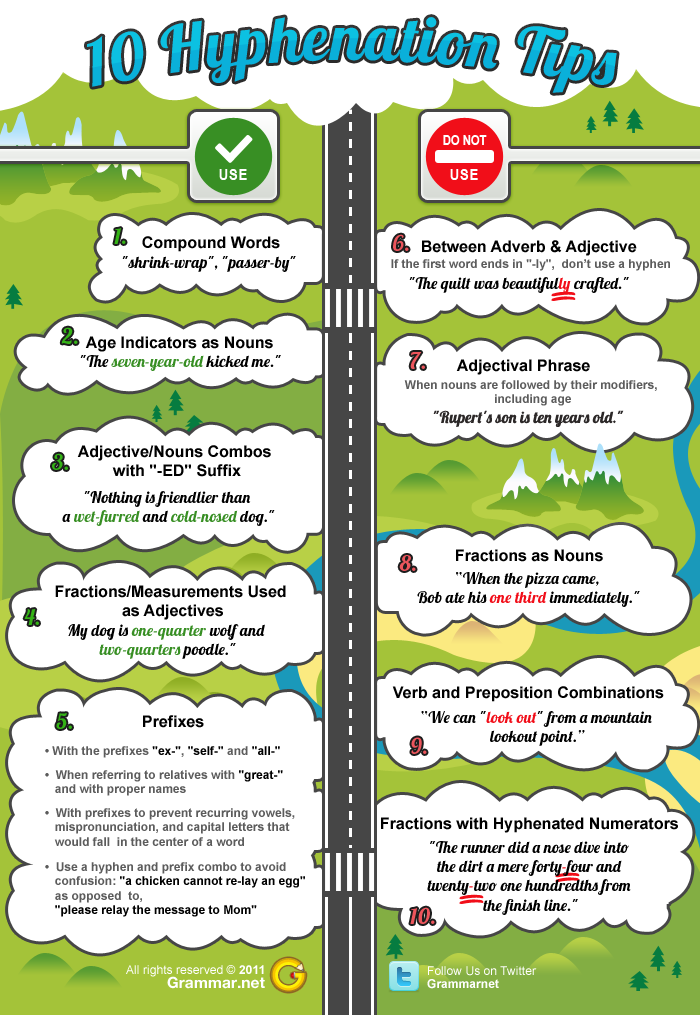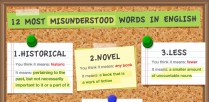Hyphenation is like kitchen spice: use them correctly, and they can sharpen writing and give it a better texture. When used incorrectly or overused, they can garble the piece and make it difficult to read.
Hyphenation Rules
Hyphen errors in a written piece are usually only distracting, but they can detract from clarity, whether by wrong placement or omission. Some writers boggle at these little pieces of punctuation and attempt to write in such a way to avoid them, but this is a shame, as hyphens can be handy.
These ten hyphen rules have been sorted into two tidy piles: when to use them and when to leave them out, or “Yes” and “No”.
You can download high-resolution poster here.Embed this image to your site:
Yes!
1) Compound Words–If the word does not appear in the dictionary as a single word, use a hyphen.
“shrink-wrap”
“passer-by”
“half-mast”
2) Age Indicators as Nouns–Hyphens cement these words together to aid clarity; use when a dimension or an age identifies a person or object.
“The seven-year-old kicked me.”
“Betty teaches a class of four- and five-year-olds.”
3) Adjective/Nouns Combos with “-ED” Suffix–It is important to attach some modifiers to the words they modify. A “light-haired man” is a man with light hair, while a “light haired man” sounds like a man who weighs very little and is covered in hair.
“Nothing is friendlier than a wet-furred and cold-nosed dog.”
“The child was close-mouthed when her mother asked where the cookies were.”
4) Fractions/Measurements Used as Adjectives–These add clarity; imagine the example sentence without the hyphens to see how each word now points to the direct object (wolf or poodle).
“My dog is one-quarter wolf and two-quarters poodle.”
“Grandpa was over one-half Cherokee.”
5) Prefixes–Hyphens are used with the prefixes “ex-“, “self-” and “all-“. Use them also when referring to relatives with “great-” and with proper names. Hyphens are used with prefixes to also prevent recurring vowels, mispronunciation, and capitol letters that would fall in the center of a word. Use a hyphen and prefix combo to avoid confusion: “a chicken cannot re-lay an egg,” as opposed to, “please relay the message to Mom.”
“ex-wife”
“self-conscious”
“all-powerful”
“great-nephew” or “grand-nephew”
“pro-Canadian”
“re-establish”
No!
6) Between Adverb and Adjective–If the first word ends in “-ly”, do not use a hyphen. The adverb is doing the job it was made for and does not need a hyphen’s help.
“The quilt was beautifully crafted.”
“In the classroom, the air was dynamically charged.”
7) Adjectival Phrase–When When their modifiers, including age, follow nouns no hyphens are needed.
“Rupert’s son is ten years old.”
“The duck was nearly four feet tall.”
8) Fractions as Nouns–When discussing the individual parts of the noun, do not use hyphens.
“When the pizza came, Bob ate his one third immediately.”
“Two halves make a whole.”
9) Verb and Preposition Combinations–The verb form is different from the noun/adjective.
We can “look out” from a mountain lookout point.
We can “check out” in the checkout line.
10) Fractions with Hyphenated Numerators–When part of a fraction is already hyphenated, do not hyphenate it further, or the readers’ eyes will cross.
“The runner did a nose dive into the dirt a mere forty-four and twenty-two one hundredths from the finish line.”
As English evolves, the dictionaries gradually add words, and some of the common words that had hyphens a century ago are used without hyphens now. Can you think of any?








